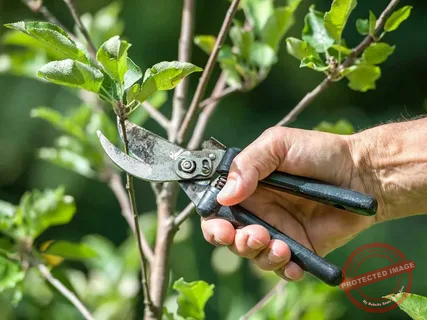Are you a gardening enthusiast living in Zone 4? Do you dream of having a lush orchard filled with thriving fruit trees despite the challenging climate? Well, you’re in luck! In this article, we will write the world’s fast-growing fruit trees that not only survive but thrive in Zone 4’s colder temperatures. Get ready to transform your garden into a fruitful paradise.
The fast-growing fruit trees for Zone 4 gardens, from classic favorites like apple and cherry trees to unique options like pawpaw and haskap not only withstand the challenges of colder climates but also provide a rich array of flavors and fruits to delight every gardener.
20 Fastest Growing Fruit Trees Zone 4
1. Apple Trees (Malus domestica)
Apple trees are a Zone 4 staple, boasting an array of cultivars that flourish in colder climates. From the classic ‘Haralson’ to the sweet ‘Honeycrisp,’ these trees offer an abundance of crisp and juicy fruits. Imagine plucking a fresh apple from your own backyard!
Read Also: 30 Fast Growing Fruit Trees Zone 3
2. Cherry Trees (Prunus spp.)
Cherry trees add elegance and flavor to any garden. Varieties like the ‘Montmorency’ tart cherry and the ‘Stella’ sweet cherry thrive in Zone 4. Revel in their stunning blossoms in spring and relish the sweet rewards come summer.
3. Pear Trees (Pyrus spp.)
Pear trees are known for their graceful beauty and delectable fruits. Varieties such as ‘Bartlett’ and ‘Anjou’ can withstand colder temperatures, gracing your garden with delicate white blossoms and juicy pears.
Read Also: 40 Fast Growing Fruit Trees Zone 2
4. Plum Trees (Prunus domestica)
Plum trees offer both aesthetic and culinary delight. With varieties like ‘Stanley’ and ‘Methley,’ you can enjoy their vibrant blossoms and indulge in the harvest of sweet and juicy plums.
5. Peach Trees (Prunus persica)
Peach trees in Zone 4? Absolutely! Certain cultivars, including ‘Reliance’ and ‘Harcrest,’ are bred to thrive in colder climates. Enjoy the delight of biting into a succulent, homegrown peach.
6. Apricot Trees (Prunus armeniaca)
Apricot trees thrive in Zone 4 gardens, providing not only stunning blooms but also the joy of harvesting aromatic and sweet apricots. They’re perfect for fresh eating or creating jams.
Read Also: 20 Fast Growing Fruit Trees Zone 7
7. Nectarine Trees (Prunus persica var. nucipersica)
Nectarines, close relatives of peaches, also have their Zone 4 champions. Varieties like ‘Mericrest’ and ‘Hardired’ offer a unique twist on the classic peach flavor.
8. Sour Cherry Trees (Prunus cerasus)
Sour cherry trees are hardy in cold climates and offer a tangy twist to your garden. Enjoy the fruits of your labor by making delicious pies, preserves, and more.
9. Siberian Crabapple (Malus baccata)
Siberian crabapple trees add a touch of charm with their delicate blossoms and small, colorful fruits. They’re perfect for creating homemade jellies and preserves.
Read Also: 20 Fast Growing Fruit Trees Zone 8
10. Serviceberry (Amelanchier spp.)
Serviceberry trees, also known as Juneberries, produce berries that resemble blueberries and taste like a mix of blueberries and apples. These versatile trees provide both ornamental beauty and delicious treats.
11. Mulberry Trees (Morus spp.)
Mulberry trees are known for their rapid growth and generous harvest of dark, sweet berries. These trees not only provide a delicious treat for you but also attract various wildlife, making them a dynamic addition to your garden.
12. Kiwi Vines (Actinidia spp.)
Kiwi vines might seem unconventional for Zone 4, but certain hardy varieties like ‘Issai’ and ‘Hardy Red’ can thrive with proper care. These vines produce fuzzy, nutrient-rich fruits that bring a touch of the tropics to your garden.
Read Also: 30 Fast Growing Vegetables in Winter
13. Pawpaw Trees (Asimina triloba)
Pawpaw trees are native to North America and offer a unique flavor reminiscent of banana and mango. Their greenish fruits might not win a beauty contest, but their rich taste makes up for it.
14. Hardy Fig Trees (Ficus carica)
Hardy fig trees have defied the odds by adapting to colder climates. Varieties like ‘Chicago Hardy’ and ‘Brown Turkey’ can produce sweet and flavorful figs, even in Zone 4.
15. Raspberry Bushes (Rubus spp.)
Raspberry bushes might not be trees, but they surely deserve a mention. With their rapid growth and delicious berries, raspberries are a favorite among gardeners. Enjoy them fresh or use them in jams, pies, and more.
16. Blackberry Bushes (Rubus spp.)
Blackberry bushes offer a similar experience to raspberries. These fast-growing plants yield plump and juicy blackberries that are perfect for a multitude of culinary delights.
Read Also: 20 Fast Growing Fruit Trees Zone 6
17. Gooseberry Bushes (Ribes spp.)
Gooseberry bushes thrive in cooler climates and produce tart berries that are prized for jams, jellies, and desserts. Their unique flavor adds a zing to your culinary creations.
18. Haskap (Lonicera caerulea)
Haskap, also known as honeyberries, are gaining popularity for their antioxidant-rich berries. These elongated fruits have a sweet-tart flavor profile that combines the best of blueberries and raspberries.
19. Elderberry Bushes (Sambucus spp.)
Elderberries have gained recognition for their health benefits. The berries are commonly used to make syrups, wines, and various culinary delights.
20. Cornelian Cherry (Cornus mas)
Cornelian cherry trees offer a burst of color with their vibrant fruits. While they might not be as familiar as other fruits, they’re prized for making jams, preserves, and even liqueurs.
Understanding Zone 4 and its Challenges
It’s essential to understand the unique challenges posed by Zone 4. With its cold winters and shorter growing seasons, this region demands resilient and adaptable trees that can withstand frost and temperature fluctuations.
Nurturing Your Fruit Trees
Planting fruit trees is just the beginning. To ensure their growth and productivity, proper care and maintenance are crucial.
Site Selection: Where Roots Flourish
Choose a planting location with well-draining soil and adequate sunlight. Proper site selection sets the foundation for healthy tree growth.
Pruning: Shaping for Success
Regular pruning helps maintain the shape of the tree and encourages better air circulation. Pruning in late winter promotes new growth in spring.
Watering: Hydration is Key
Especially during the first few years, consistent watering is essential. Deep watering encourages deep root growth and overall tree resilience.
Fertilization: Feeding for Growth
Applying balanced fertilizer in spring supports healthy growth and robust fruit production. Follow the recommended dosage for your specific tree type.
Harvesting the Rewards
As your fruit trees mature, the excitement of harvesting your homegrown produce becomes a reality
Monitoring Ripeness
Each fruit has its own indicators of ripeness. For apples, a slight twist should detach the fruit from the branch. Pears, on the other hand, are ready when they yield to gentle pressure near the stem.
Harvesting Techniques: Gentle Handling
When picking fruits, use a gentle twisting motion to avoid damaging the branches. Handle the fruits carefully to prevent bruising.
Storage Tips
Store your harvested fruits in cool, dry places. Some fruits can be stored in the refrigerator, while others, like apples, are best stored in a cool basement.
What is the fastest growing tree for Zone 4?
Discover the Siberian Crabapple (Malus baccata), a remarkable choice that boasts rapid growth, delicate blossoms, and small colorful fruits, making it a standout addition to Zone 4 gardens.
Looking for the best fast-growing fruit trees for Zone 4?
From the timeless Apple (Malus domestica) to the exotic Haskap (Lonicera caerulea), these trees offer speedy growth, splendid blossoms, and a delectable variety of fruits, transforming your garden into a flourishing paradise.
Seeking the best apple trees for Zone 4?
Explore classics like the ‘Haralson’ and ‘Honeycrisp,’ renowned for their resilience in cold climates, charming blossoms, and an array of delicious apples that will thrive and delight in your Zone 4 garden.
Can I grow citrus trees in Zone 4?
Unfortunately, most citrus trees require warmer climates and would struggle to survive in Zone 4.
How long does it take for fruit trees to bear fruit?
The time it takes for fruit trees to bear fruit varies. Some trees may start producing fruit within a couple of years, while others might take several years.
Are there any self-pollinating fruit trees for small gardens?
Yes, certain fruit tree varieties, such as self-pollinating apple and cherry trees, are suitable for smaller garden spaces.
Can I grow these trees in containers?
While it’s possible to grow fruit trees in containers, it can be challenging, especially for larger trees. Dwarf varieties are better suited for container gardening.
How do I protect my fruit trees from winter frost?
Wrapping the tree trunk with burlap and applying a layer of mulch around the base can help protect fruit trees from winter frost.
Conclusion
Zone 4 gardeners have a diverse array of fast-growing fruit trees to choose from. Whether you’re aiming for the classic flavors of apples and cherries or looking to experiment with unique options like pawpaws and haskap, there’s something for everyone. With proper care and attention, you can create a garden that not only withstands the challenges of Zone 4 but thrives and brings you bountiful rewards.



